PYTHON3中文教程
python3菜鸟教程

python3菜鸟教程以下是Python3菜鸟教程的内容:Python是一种简单易学、功能强大的编程语言。
它具有清晰而易于阅读的语法,使得新手也能快速上手。
Python3菜鸟教程提供了对Python基础知识的全面指导。
包括变量、数据类型、运算符、控制流、函数、列表、元组、字典、文件操作等。
Python中的变量是用来存储数据的容器。
它们可以存储不同类型的数据,如整数、浮点数、字符串等。
Python中的数据类型包括数值类型、字符串类型、布尔类型等。
运算符用于执行各种数学和逻辑运算。
Python支持常见的算术运算符(如加法、减法、乘法、除法),以及比较运算符(如大于、小于、等于)等。
控制流用于根据条件执行不同的代码块。
Python使用if语句和循环语句来实现控制流。
if语句用于根据条件选择性地执行代码,而循环语句用于重复执行代码。
函数是一段可重用的代码块,用于执行特定的任务。
Python中的函数由def关键字定义,并且可以带有参数和返回值。
列表是一种有序的可变序列,它可以存储多个值。
Python的列表使用方括号表示,并且可以进行索引、切片、拼接等操作。
元组类似于列表,但是不可变。
一旦创建,元组中的元素不能被修改。
元组使用圆括号表示,并且可以进行索引、切片等操作。
字典用于存储键值对,它是一种无序的可变容器。
Python的字典使用花括号表示,通过键来访问对应的值。
文件操作用于读取和写入文件。
Python提供了open()函数来打开文件,并且可以使用read()、write()等方法来操作文件的内容。
以上是Python3菜鸟教程的部分内容,希望对你学习Python 有所帮助。
python3简明教程

python3简明教程Python3是一种高级编程语言,它的设计目标是简单、易读、易学。
Python3 语言具有简洁的语法、丰富的标准库和强大的解释器,在计算机编程领域得到了广泛的应用。
本教程将介绍 Python3 的基本语法、数据类型、控制流、函数、模块等知识点,帮助初学者快速入门 Python3 编程。
第一章:Python3 简介Python3 是由 Guido van Rossum 于 1989 年创造的一种高级编程语言,它的设计目标是简单、易读、易学。
Python3 语言具有简洁的语法、丰富的标准库和强大的解释器,在计算机编程领域得到了广泛的应用。
Python3 语言的主要特点包括:1. 语法简单:Python3 语言的语法非常简单,易于学习和理解。
2. 可移植性强:Python3 语言可以在不同的操作系统和平台上运行,包括 Windows、Linux 和 Mac OS 等。
3. 面向对象:Python3 语言是一种面向对象的编程语言,支持类、对象、继承等特性。
4. 标准库丰富:Python3 语言的标准库包含了众多的模块和函数,可以满足不同的编程需求。
第二章:Python3 基本语法Python3 语言的基本语法非常简单,下面是一些常用的语法规则: 1. 变量命名:Python3 语言的变量命名规则为字母、数字和下划线的组合,且不能以数字开头。
2. 注释:Python3 语言的注释使用 # 符号,可以在代码中添加注释来说明代码的功能。
3. 缩进:Python3 语言使用缩进来表示代码块,缩进的空格数必须一致。
4. 字符串:Python3 语言使用单引号或双引号来表示字符串,可以使用 + 运算符来连接字符串。
5. 数字:Python3 语言支持整数、浮点数和复数等数字类型。
6. 列表:Python3 语言使用 [] 符号来表示列表,列表中的元素可以是任意类型。
7. 元组:Python3 语言使用 () 符号来表示元组,元组中的元素可以是任意类型,但不能修改。
Python中文手册(汉译)Word文字可编辑版
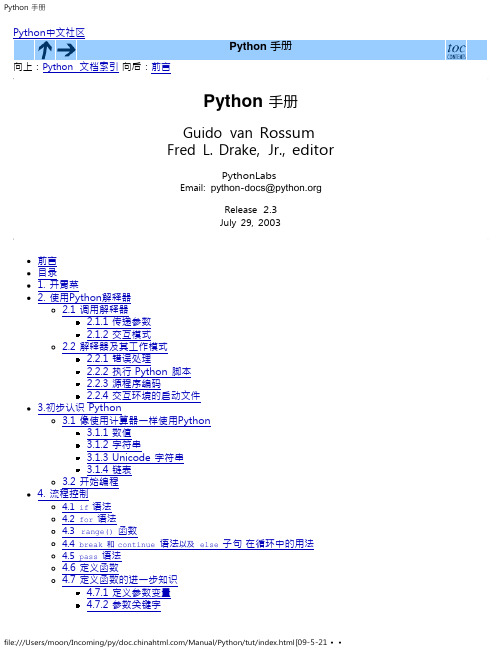
Python 手册Python中文社区Python 手册向上:Python 文档索引向后:前言Python 手册Guido van RossumFred L. Drake, Jr., editorPythonLabsEmail: **********************Release 2.3July 29, 2003前言目录1. 开胃菜2. 使用Python解释器2.1 调用解释器2.1.1 传递参数2.1.2 交互模式2.2 解释器及其工作模式2.2.1 错误处理2.2.2 执行 Python 脚本2.2.3 源程序编码2.2.4 交互环境的启动文件3.初步认识Python3.1 像使用计算器一样使用Python3.1.1 数值3.1.2 字符串3.1.3 Unicode 字符串3.1.4 链表3.2 开始编程4. 流程控制4.1 if 语法4.2 for 语法4.3 range() 函数4.4 break 和continue 语法以及else 子句在循环中的用法4.5 pass 语法4.6 定义函数4.7 定义函数的进一步知识4.7.1 定义参数变量4.7.2 参数关键字4.7.3 可变参数表4.7.4 Lambda 结构4.7.5 文档字符串5. 数据结构5.1 深入链表5.1.1 将链表作为堆栈来使用5.1.2 将链表作为队列来使用5.1.3 函数化的编程工具5.1.4 链表的内含(Comprehensions)5.2 del 语法5.3 Tuples 和 Sequences5.4 字典(Dictionaries)5.5 循环技巧5.6 深入条件控制5.7 Sequences 和其它类型的比较6. 模块6.1 深入模块6.1.1 模块搜索路径6.1.2 “编译” Python 文件6.2 标准模块6.3 dir() 函数6.4 包6.4.1 从包中导入所有内容(import * )6.4.2 隐式包引用6.4.3 包中的多重路径7. 输入和输出7.1 格式化输出7.2 读写文件7.2.1 文件对象的方法7.2.2 pickle 模块8. 错误和异常8.1 语法 Errors8.2 异常8.3 捕获异常8.4 释放异常8.5 用户自定义异常8.6 定义 Clean-up Actions9. 类9.1 一个术语9.2 Python 的生存期和命名空间9.3 类(Classes)的初步印像9.3.1 类定义语法9.3.2 类对象9.3.3 实例对象9.3.4 方法对象9.4 自由标记(Random Remarks)9.5 继承9.5.1 多继承9.6 私有变量9.7 零杂技巧9.8 异常也是类9.9 迭代子(Iterators)9.10 发生器(Generators)10. 接下来?A. 交互式编辑和历史回溯A.1 行编辑A.2 历史回溯A.3 快捷键绑定A.4 注释B. 浮点计算:问题与极限B.1 表达错误C. 历史和授权C.1 本软件的历史C.2 修改和使用Python的条件(Terms and conditions for accessing or otherwise usingPython)关于本文档Python 手册向上:Python 文档索引向后:前言Release 2.3, documentation updated on July 29, 2003.See A bout this document... for information on suggesting changes.Python中文社区前言Python中文社区Python 指南向前:Python 指南向上: P ython 指南向下:目录前言Copyright © 2001, 2002, 2003 Python Software Foundation. All rights reserved.Copyright © 2000 . All rights reserved.Copyright © 1995-2000 Corporation for National Research Initiatives. All rights reserved.Copyright © 1991-1995 Stichting Mathematisch Centrum. All rights reserved.See the end of this document for complete license and permissions information.概要:Python 是一种容易学习的强大语言。
Python3多线程菜鸟教程

Python3多线程菜鸟教程Python是一种非常常用的编程语言,与其它语言相比,Python具有简单易学、代码清晰、功能强大等优点。
在编写Python程序时,可以通过使用多线程来实现并发执行任务的目标。
本文将介绍Python3多线程的相关知识,并通过实例演示多线程的使用。
多线程是指在一个程序中同时执行多个线程。
每个线程都是独立的执行单元,可以进行不同的操作。
相比于单线程,多线程可以极大地提升程序的执行效率。
在Python中,可以使用threading模块来实现多线程。
通过创建Thread类的实例对象,可以创建并启动新的线程。
下面是一个简单的多线程示例:```pythonimport threadingdef function(:for i in range(5):print("线程执行中...")t = threading.Thread(target=function)t.startfor i in range(5):print("主线程执行中...")```多线程的另一个常见用途是进行并行计算。
当我们需要同时进行多个复杂的计算任务时,可以通过多线程来同时进行,从而提高计算效率。
除了使用threading模块,Python中还提供了concurrent.futures 模块来实现多线程。
concurrent.futures模块中的ThreadPoolExecutor 类可以用于创建线程池,从而更方便地管理和控制多个线程。
下面是一个使用ThreadPoolExecutor的示例代码:```pythonimport concurrent.futuresdef function(n):return n**2if __name__ == '__main__':with concurrent.futures.ThreadPoolExecutor( as executor:results = [executor.submit(function, i) for i in range(5)] print(future.result()```通过以上的示例代码,可以看到创建和管理多线程非常简单。
Python中文自然语言处理基础与实战教学教案(全)

Python中文自然语言处理基础与实战教学教案(全)第一章:Python中文自然语言处理简介1.1 自然语言处理的概念1.2 Python在自然语言处理中的应用1.3 中文自然语言处理的基本流程1.4 中文分词与词性标注1.5 中文命名实体识别第二章:Python中文文本处理基础2.1 文本预处理2.2 中文停用词去除2.3 词干提取与词形还原2.4 中文分词算法介绍2.5 Python库在中国分词中的应用第三章:Python中文词性标注3.1 词性标注的概念与作用3.2 基于规则的词性标注方法3.3 基于机器学习的词性标注方法3.4 Python词性标注库介绍3.5 词性标注的实战应用第四章:Python中文命名实体识别4.1 命名实体识别的概念与作用4.2 基于规则的命名实体识别方法4.3 基于机器学习的命名实体识别方法4.4 Python命名实体识别库介绍4.5 命名实体识别的实战应用第五章:Python中文情感分析5.1 情感分析的概念与作用5.2 基于词典的情感分析方法5.3 基于机器学习的情感分析方法5.4 Python情感分析库介绍5.5 情感分析的实战应用本教案将为您提供Python中文自然语言处理的基础知识与实战应用。
通过学习,您将掌握Python在中文自然语言处理中的应用,包括文本预处理、中文分词、词性标注、命名实体识别和情感分析等方面。
每个章节都包含相关概念、方法、库介绍和实战应用,帮助您深入了解并实践中文自然语言处理。
希望本教案能为您在学习Python 中文自然语言处理方面提供帮助。
第六章:Python中文文本分类6.1 文本分类的概念与作用6.2 特征提取与降维6.3 常用的文本分类算法6.4 Python文本分类库介绍6.5 中文文本分类的实战应用第七章:Python中文信息抽取7.1 信息抽取的概念与作用7.2 实体抽取与关系抽取7.3 事件抽取与意见抽取7.4 Python信息抽取库介绍7.5 中文信息抽取的实战应用第八章:Python中文文本8.1 文本的概念与作用8.2 模型与判别模型8.3 循环神经网络(RNN)与长短时记忆网络(LSTM)8.4 Python文本库介绍8.5 中文文本的实战应用第九章:Python中文对话系统9.1 对话系统的概念与作用9.2 对话系统的类型与架构9.3 式对话模型与检索式对话模型9.4 Python对话系统库介绍9.5 中文对话系统的实战应用第十章:Python中文语音识别与合成10.1 语音识别与合成的概念与作用10.2 基于深度学习的语音识别与合成方法10.3 Python语音识别与合成库介绍10.4 中文语音识别与合成的实战应用10.5 语音识别与合成的综合实战项目第十一章:Python中文语义理解11.1 语义理解的概念与作用11.2 词嵌入与语义表示11.3 语义分析与语义相似度计算11.4 Python语义理解库介绍11.5 中文语义理解的实战应用第十二章:Python中文问答系统12.1 问答系统的概念与作用12.2 基于知识图谱的问答方法12.3 基于机器学习的问答方法12.4 Python问答系统库介绍12.5 中文问答系统的实战应用第十三章:Python中文文本摘要13.1 文本摘要的概念与作用13.2 提取式摘要与式摘要13.3 文本摘要的评价指标13.4 Python文本摘要库介绍13.5 中文文本摘要的实战应用第十五章:Python中文自然语言处理综合实战15.1 自然语言处理综合实战项目介绍15.2 项目需求分析与设计15.3 项目实施与技术选型15.4 项目测试与优化15.5 项目总结与展望重点和难点解析重点:Python在中文自然语言处理中的应用场景。
Python3学习资料

Python3学习资料⼀、python3 学习计划Python⼊门学习计划安排:(按序号来)推荐直接从Python3开始学起。
参考了 Python3.x基础学习资料整理第⼀⽬标是:通过学习python学会编程。
第⼆⽬标:会写爬⾍,⽹页采集。
第三⽬标:学会web开发。
1、推荐廖雪峰⽼师的⽹站:(强烈建议你从⽬录的开始学到结束)。
2、看以下⽹站学习:Python3官⽅指南(中⽂):Python3官⽅教程(中⽂):Python ⼊门指南:Python3 教程 | 菜鸟教程:Python最佳实践指南:更多的学习资源:视频补充:1、爬⾍⽅向:2、数据分析实战:3、Django web开发:⼆、python3学习推荐书籍、视频1、推荐书籍Python编程快速上⼿:让繁琐⼯作⾃动化(⼊门,但细节不够)Python编程:从⼊门到实践(⼊门,推荐)Python参考⼿册(第4版)(⼊门,推荐)Python程序设计戴维 I.施奈德(David I. Schneider)著;车万翔译(⼊门)Effective Python:编写⾼质量Python代码的59个有效⽅法(推荐)Python学习⼿册 Mark Lutz (第4版)(很厚的书)Python语⾔及其应⽤ Bill Lubanovic (⼊门,推荐)像计算机科学家⼀样思考Python 第2版其他⼊门书籍:1、《笨⽅法学Python》英⽂名(learn python the hard way)中译版的电⼦版:Python 核⼼编程第⼆版(进阶)Python Cookbook(第3版) (进阶,推荐)Python编程实战:运⽤设计模式、并发和程序库创建⾼质量程序(作为进阶!)Python性能分析与优化(进阶)《Python Web开发测试驱动⽅法》(进阶,重点推荐)《python标准库》 Doug Hellmann (可当做⼯具书)⾼性能Python 作者: (美)⼽雷利克 / (英)欧⽇沃尔德《Python⽂本分析》Python Cookbook(在线预览)2、推荐视频3、其他资料python3.8 新特性:千⾏代码⼊门Python:8 个 Python 实⽤脚本:5 个 Python 特性:从0到1,Python Web开发的进击之路:GitHub上Stars最多的10个Python项⽬Python⾯试题-概念篇:Python⾯试题-代码篇:有哪些学习数据分析的⽹站:项⽬试验:Python练习⼩项⽬:Python 100例练习题:Python 100例(菜鸟教程)美图2018春招笔试题⽬-算法⽅向:京东2019春招编程题参考代码:如何训练⾃⼰的编程思路?三、Python编程规范和风格指南Google 开源项⽬风格指南——中⽂版(Python语⾔)Python 代码风格指南:PEP8,原⽂:PEP8中⽂:r代码排版,命名与注释:。
python3.0入门经典教程

python3.0入门经典教程Python是一种功能很强大的语言,关于零基础学习Python还是有难度的,但只要学习方法对,入门还是很快哒。
下面介绍几种学习Python的方法。
以下是我为你整理的〔python〕3.0入门经典教程首先是书籍,通过书籍学习,虽然速度会有些慢,但知识具体,可以掌握很多细节,一旦入门后,后面进步就很快了,下面介绍给大家一本书,是以前我学习Python时用的书,感觉还挺不错哒。
然后就是借助网络学习,网上有很多视频课程,而且有很多是免费哒,网络视频比较直观,入门快。
给大家推举一个视频,网易云课堂里有个零基础入门学习python的视频,是免费的,我之前也看过,挺不错哒还有就是加一些群或是论坛,里面的知识虽然不全面,但关于知识的扩宽还是很有帮助哒。
最后说说我的学习经验,书籍学习的方法比较扎实,网络视频学习的方法入门比较快,论坛可以作为知识的补充渠道,当然,如果想学精,唯有多多施行一条途径。
优点是什么Python世界最棒的地方之一,就是大量的第三方程序包。
同样,〔管理〕这些包也非常容易。
按照惯例,会在 requirements.txt 文件中列出项目所必须要的包。
每个包占一行,通常还包涵版本号。
这里有一个例子Python 程序包有一个缺陷是,它们默认会进行全局安装。
我们将要使用一个工具,使我们每个项目都有一个独立的环境,这个工具叫virtualenv。
我们同样要安装一个更高级的包管理工具,叫做pip,他可以和virtualenv配合工作。
首先,我们必须要安装pip。
大多数python安装程序已经内置了easy_install(python默认的包管理工具),所以我们就使用easy_install pip来安装pip。
这应该是你最后一次使用easy_install 了。
如果你并没有安装easy_install ,在〔linux〕系统中,貌似从python-setuptools 包中可以获得。
python中文参考手册
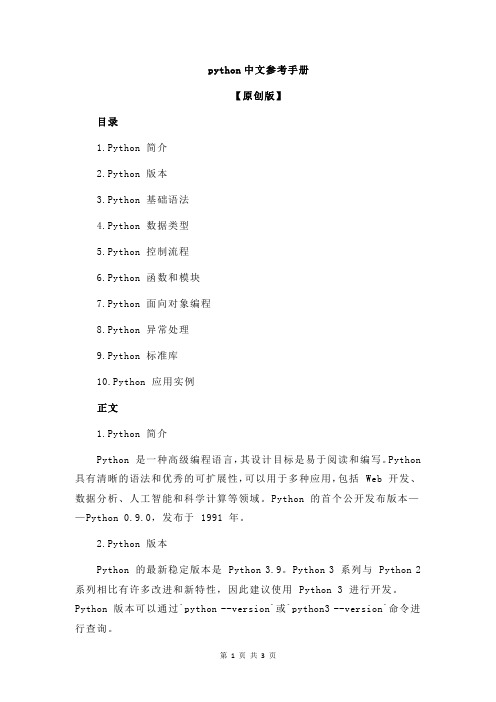
python中文参考手册【原创版】目录1.Python 简介2.Python 版本3.Python 基础语法4.Python 数据类型5.Python 控制流程6.Python 函数和模块7.Python 面向对象编程8.Python 异常处理9.Python 标准库10.Python 应用实例正文1.Python 简介Python 是一种高级编程语言,其设计目标是易于阅读和编写。
Python 具有清晰的语法和优秀的可扩展性,可以用于多种应用,包括 Web 开发、数据分析、人工智能和科学计算等领域。
Python 的首个公开发布版本——Python 0.9.0,发布于 1991 年。
2.Python 版本Python 的最新稳定版本是 Python 3.9。
Python 3 系列与 Python 2 系列相比有许多改进和新特性,因此建议使用 Python 3 进行开发。
Python 版本可以通过`python --version`或`python3 --version`命令进行查询。
3.Python 基础语法Python 的基础语法包括变量、常量、运算符、注释等。
Python 中的变量不需要声明类型,它是一种动态类型的语言。
Python 使用缩进来表示代码块,例如:`if x > 10:`。
4.Python 数据类型Python 的数据类型包括数字、字符串、列表、元组、字典和集合等。
这些数据类型具有不同的特点和使用方法。
例如,列表是一种有序、可变的集合,可以使用`[]`来创建。
5.Python 控制流程Python 的控制流程语句包括条件判断(if-elif-else)、循环(for 和while)和分支(try-except)。
这些语句可以帮助程序员控制程序的执行流程。
6.Python 函数和模块Python 函数是一段可重用的代码,用于执行特定任务。
Python 模块是包含 Python 代码的文件,可以被导入并使用其中的函数和变量。
python3.0使用方法

python3.0使用方法Python 3.0是Python语言的第三个主要版本,带来了许多新特性和改进。
下面是一些在Python 3.0中使用的基本方法:1. 打印输出:在Python 3.0中,print函数是一个内置函数,而不是一个语句。
因此,要打印输出,需要使用括号将内容括起来,例如:```pythonprint("Hello, World!")```2. 字符串连接:在Python3.0中,字符串连接可以使用加号(+)或format()方法实现,例如:```pythonstr1 = "Hello, "str2 = "World!"result = str1 + str2 # 使用加号连接字符串print(result) # 输出:Hello, World!result = format(str1, str2) # 使用format()方法连接字符串并返回一个新的字符串对象print(result) # 输出:Hello, World!```3. 注释:在Python 3.0中,注释使用井号(#)开头,例如:```python# 这是一个注释print("Hello, World!") # 这也是一个注释```4. 异常处理:在Python 3.0中,异常处理结构与Python 2.x版本相同,但有一些微小的语法差异。
例如:```pythontry:# 尝试执行一些代码块result = 1 / 0 # 这里会引发一个ZeroDivisionError异常except ZeroDivisionError:# 处理异常的代码块print("除数为零错误")```5. 多行字符串:在Python 3.0中,可以使用三引号(''')或三单引号(""")来定义多行字符串,例如:```pythonmultiline_string = """这是一个多行字符串。
Python3教程菜鸟教程

Python3教程菜鸟教程Python3教程Python是一种广泛使用的高级编程语言,它简洁、易学且功能强大。
Python3是Python语言的最新版本,其优化了许多细节,提供了更好的性能和更强大的功能。
本教程将为初学者提供Python3基础知识和编程技巧,以帮助他们迅速掌握这门语言。
一、Python3的安装要开始学习Python3,我们首先需要在计算机上安装Python解释器。
Python官网提供了Windows、Mac和Linux等操作系统对应的安装包。
下载并运行适合你操作系统的安装程序,按照指示进行安装即可。
二、Python3的基本语法Python的基本语法非常简洁易懂,这使得它成为学习编程的理想选择。
下面是一些常用的Python语法要点:1. 变量和数据类型在Python中,你无需提前声明变量的类型,直接赋值即可创建变量。
Python支持多种数据类型,包括整数、浮点数、布尔值、字符串等等。
要注意变量名的命名规范,它应该以字母或下划线开头,并避免使用Python的关键字作为变量名。
2. 条件和循环Python提供了if语句和for/while循环,以支持条件判断和循环执行。
if语句用于根据条件执行不同的代码块,而for/while循环可重复执行一段代码。
3. 函数和模块函数是一段可重复使用的代码块,用于完成特定任务。
在Python中,我们可以使用def关键字来定义函数,并通过传递参数来实现代码的灵活性。
此外,Python还提供了各种内置函数和模块,以便我们更方便地开发程序。
三、Python3的高级特性除了基本语法外,Python3还提供了许多高级特性,使得程序编写更加高效和便捷。
以下是一些值得注意的高级特性:1. 列表推导式列表推导式提供了一种简洁的方式来创建列表。
我们可以使用一行代码快速生成指定规则的列表,减少了繁琐的步骤。
2. 迭代器和生成器迭代器和生成器是Python中非常实用的特性。
python3.0入门教程
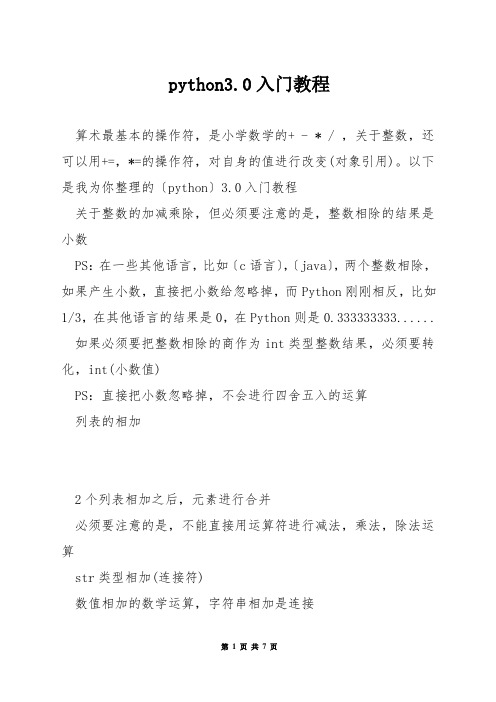
python3.0入门教程算术最基本的操作符,是小学数学的+ - * / ,关于整数,还可以用+=,*=的操作符,对自身的值进行改变(对象引用)。
以下是我为你整理的〔python〕3.0入门教程关于整数的加减乘除,但必须要注意的是,整数相除的结果是小数PS:在一些其他语言,比如〔c语言〕,〔java〕,两个整数相除,如果产生小数,直接把小数给忽略掉,而Python刚刚相反,比如1/3,在其他语言的结果是0,在Python则是0.333333333......如果必须要把整数相除的商作为int类型整数结果,必须要转化,int(小数值)PS:直接把小数忽略掉,不会进行四舍五入的运算列表的相加2个列表相加之后,元素进行合并必须要注意的是,不能直接用运算符进行减法,乘法,除法运算str类型相加(连接符)数值相加的数学运算,字符串相加是连接比如:abc+def,结果是abcdef必须要注意的是,字符串只能用+号连接,不能用乘除减符号 +=,-=,*=,/=必须要注意的是,这种赋值不是改变原本的数据,而且进行运算之后产生一个新的数据,然后a重新指向新数据,原来的数据如果没有被任何标识符引用,那么会进入等待垃圾回收器清理另外,这类操作符的左边是一个集合的时候,右边也必须要是集合有一个必须要注意的是字符串集合与字符串相加比如,[abc]与def相加,不能用a = a + b,要用a += b 解析:直接相加,相当于用列表与字符串相加,如果用+=,会默认把后面的字符串转成列表python的解释解释是什么?我们写程序的时候,是否要标明程序的作用。
例如函数、对象、方法的作用、源代码的等。
也就是说python解释器不解释的部分,用来我们开发时可以一目了然的功能标明,就是解释。
怎么解释呢?这里分单行解释和多行解释。
什么是单行解释?也就是说单行解释,标识符为#什么是多行解释?多行解释一般用于、版本标明。
标识符为3个或者当然你也可以用单行解释来实现多行解释。
(完整word版)python3基础教程

Python 基础教程Python是一种解释型、面向对象、动态数据类型的高级程序设计语言。
Python由Guido van Rossum于1989年底发明,第一个公开发行版发行于1991年.像Perl语言一样,Python 源代码同样遵循GPL(GNU General Public License)协议.现在开始学习Python!谁适合阅读本教程?本教程适合想从零开始学习Python编程语言的开发人员。
当然本教程也会对一些模块进行深入,让你更好的了解Python的应用。
学习本教程前你需要了解在继续本教程之前,你应该了解一些基本的计算机编程术语.如果你学习过PHP,ASP等编程语言,将有助于你更快的了解Python编程。
执行Python程序对于大多数程序语言,第一个入门编程代码便是”Hello World!",以下代码为使用Python输出”Hello World!":实例(Python 2.0+)#!/usr/bin/pythonprint "Hello,World!”;运行实例»Python 3.0+版本已经把print作为一个内置函数,正确输出"Hello World!"代码如下:实例(Python 3.0+)#!/usr/bin/pythonprint("Hello,World!”);Python 简介Python 是一个高层次的结合了解释性、编译性、互动性和面向对象的脚本语言。
Python 的设计具有很强的可读性,相比其他语言经常使用英文关键字,其他语言的一些标点符号,它具有比其他语言更有特色语法结构。
Python 是一种解释型语言: 这意味着开发过程中没有了编译这个环节。
类似于PHP和Perl语言。
Python 是交互式语言: 这意味着,您可以在一个Python提示符,直接互动执行写你的程序。
Python 是面向对象语言: 这意味着Python支持面向对象的风格或代码封装在对象的编程技术。
python3asyncio官方文档中文版

python3asyncio官⽅⽂档中⽂版1. 事件循环基类2. 事件循环基类事件循环是由asyncio提供的核⼼执⾏装置。
它提供了多种服务,包括:注册、执⾏和关闭延时调⽤(超时)为各种通信创建客户端和服务端传输为⼀个外部程序通信启动⼦进程和相关的传输把⾼成本的函数调⽤委托到线程池class asyncio.BaseEventLoop 此类是⼀个实现细节。
此类是AbstractEventLoop的⼦类,是你在asyncio中找到的具体事件循环类的基类。
它不应该被直接使⽤,⽽是使⽤AbstractEventLoop来代替它。
BaseEventLoop不应该被第三⽅代码继承,它的内部接⼝并不稳定。
class asyncio.AbstractEventLoop 事件循环抽象基类。
这个类不是线程安全的。
1.1. 运⾏事件循环AbstractEventLoop.run_forever() ⼀直运⾏直到stop()被调⽤。
如果stop()在run_forever()之前被调⽤,它将轮询⼀次I/O selector(timeout为0),然后运⾏所有响应I/O事件的回调(以及那些已经被安排的回调),然后退出。
如果stop()在run_forever()运⾏时被调⽤,它将运⾏当前的⼀批回调然后退出。
请注意,那些被回调函数安排的回调不会在这种情况下运⾏;它们将会在下⼀次run_forever被调⽤时运⾏。
改动于3.5.1版本。
AbstractEventLoop.run_until_complete(future) ⼀直运⾏直到future运⾏完成。
如果参数是⼀个协程对象,它将被ensure_future()打包。
返回Future的结果,或者引发它的异常。
AbstractEventLoop.stop() 停⽌运⾏事件循环。
它将在⼀个适当的时机使得run_forever()退出。
改动于3.5.1版本。
AbstractEventLoop.is_closed() 当事件循环关闭时返回True。
Python3入门基础教程

Python3⼊门基础教程引:此⽂是⾃⼰学习python过程中的笔记和总结,适合有语⾔基础的⼈快速了解python3和没基础的作为学习的⼤纲,了解学习的⽅向、知识点;笔记是从多本书和视频上学习后的整合版。
(⼀)初识python1、⼀般⽂件以.py为格式;⽤#作注释.2、⼀般对象不⽤特别声明,python会⾃动识别;⼀个对象也可以重新绑定到不同数据类型,因为python采⽤的是动态类型机制;但对已经声明过的对象则不能改变。
3、输出print("a"),在python控制台中也可以直接⽤这个对象名称,就会打印出来,⽤print打印多个字符串可⽤逗号连接,想将多个print打印在同⼀⾏,可以print后加上end=参数(例:print(x,end=" "),会以空格分隔)。
输⼊input()4、字符串可以⽤双引号或者单引号封装;5、⼀个字符串可以通过[]来提取序列中的某⼀项;"abcd"[1]=="b";6、len()会返回⼀个元组的长度;7、元组的元素追加append,x.append("more");或者list.append(x,"more");元组也可以通过[]提取组内的某⼀个元素;8、python语句结尾可不⽤标点符号,两个语句之间也可⽤分号分隔.9、代码中的缩进排版⽅式是会影响程序的运⾏结果的!!!⽽且是⾮常⾮常重要...10、内置打开⽂件函数open()返回⼀个⽂件对象(如果是⽂本⽂件,则类型为io.TestIOWrapper),函数有⼀个必须参数(⽂件名,可包含路径)和6个可选参数。
常⽤格式:fin=open(filename,encoding="utf8") #for reading textfout=open(filename,"w",encoding="utf8") #for writing text(如果参数是"a"则是以追加形式写⼊⽂件中)写⼊数据时⽤fout.write(string)。
python3入门教程之helloworld

python3⼊门教程之helloworld概述 python 这门语⾔这⼏年⾮常的⽕,很多技术都⽤的到,像爬⾍,⼤数据,⼈⼯智能等,包括很多的⼩孩都⾸选python作为⼊门学习语⾔,那python 究竟是怎样⼀门语⾔呢? Python 是⼀个⾼层次的结合了解释性、编译性、互动性和⾯向对象的脚本语⾔。
简单的说,python 具有以下特点:易阅读,易扩展,易学习,易移植等。
官话少说,下⾯我们开始安装,并编写第⼀个python程序。
windows安装选择点击 Downloads,选择 windows ,我们可以看到 python的所有版本我们选择windows64位直接安装的最新版本 python 3.7.0 windows x86-64 executable installer选择 customize installation全部勾选上,点击next点击 install ,等待安装完成验证安装是否成功windows键 + r 输⼊ cmd ,敲回车,输⼊python出现上⾯的样⼦,说明安装成功。
第⼀个python程序我们可以⽤很多的编辑⼯具去编写python脚本,也可以直接在上⾯的交互界⾯中直接写。
我们可以先来输出⼀个 hello world只要在上⾯的交互界⾯⾥⾯输⼊ print('hello world'),敲回车就是这么简单,就是这么直接,有没有很爽呢。
当然,简单的运⾏可以⽤上⾯的交互界⾯来进⾏,真正⼯作当中肯定⽐这复杂得多,我们得要⼀个趁⼿的兵器,我这边常⽤的pycharm,⽤起来也很⽅便。
我⽤的是这个版本,可以在官⽹上下载安装,这边不在赘述。
安装完成之后,双击打开,新建⼀个python⽂件,helloWorld.py输⼊ print('hello world')是不是很⽅便呢?。
Python3中文教程
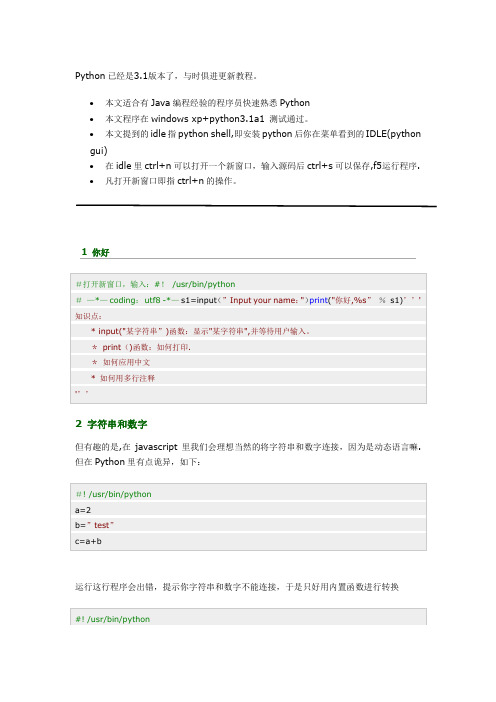
Python已经是3.1版本了,与时俱进更新教程。
•本文适合有Java编程经验的程序员快速熟悉Python•本文程序在windows xp+python3.1a1 测试通过。
•本文提到的idle指python shell,即安装python后你在菜单看到的IDLE(python gui)•在idle里ctrl+n可以打开一个新窗口,输入源码后ctrl+s可以保存,f5运行程序.•凡打开新窗口即指ctrl+n的操作。
1 你好2 字符串和数字但有趣的是,在javascript里我们会理想当然的将字符串和数字连接,因为是动态语言嘛.但在Python里有点诡异,如下:运行这行程序会出错,提示你字符串和数字不能连接,于是只好用内置函数进行转换3 列表4 字典5 字符串比起C/C++,Python处理字符串的方式实在太让人感动了。
把字符串当列表来用吧。
中文和英文的字符串长度是否一样?知识点:•类似Java,在python3里所有字符串都是unicode,所以长度一致。
6 条件和循环语句7 函数一个好用的函数知识点:•Python 不用{}来控制程序结构,他强迫你用缩进来写程序,使代码清晰.•定义函数方便简单•方便好用的range函数8 异常处理9 文件处理对比Java,python的文本处理再次让人感动知识点:•open的参数:r表示读,w写数据,在写之前先清空文件内容,a打开并附加内容。
•打开文件之后记得关闭10 类和继承11 包机制每一个。
py文件称为一个module,module之间可以互相导入.请参看以下例子:module可以定义在包里面。
Python定义包的方式稍微有点古怪,假设我们有一个parent 文件夹,该文件夹有一个child子文件夹.child中有一个module a。
py . 如何让Python 知道这个文件层次结构?很简单,每个目录都放一个名为_init_.py 的文件.该文件内容可以为空。
Python3基础教程(十九)——项目结构
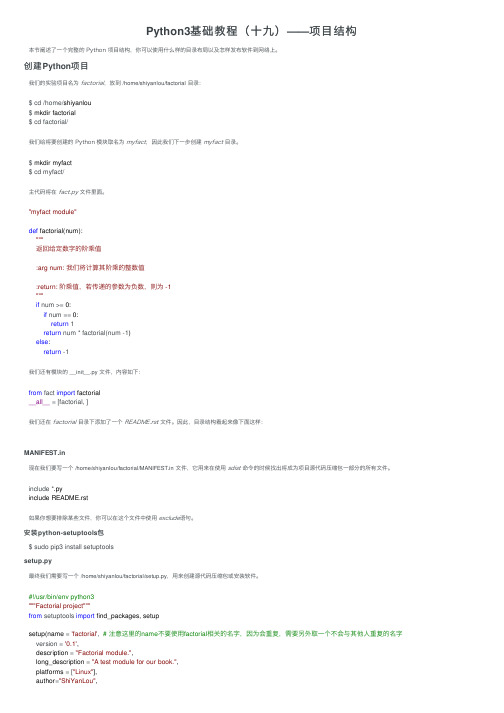
Python3基础教程(⼗九)——项⽬结构本节阐述了⼀个完整的 Python 项⽬结构,你可以使⽤什么样的⽬录布局以及怎样发布软件到⽹络上。
创建Python项⽬我们的实验项⽬名为 factorial,放到 /home/shiyanlou/factorial ⽬录:$ cd /home/shiyanlou$ mkdir factorial$ cd factorial/我们给将要创建的 Python 模块取名为 myfact,因此我们下⼀步创建 myfact ⽬录。
$ mkdir myfact$ cd myfact/主代码将在 fact.py ⽂件⾥⾯。
"myfact module"def factorial(num):"""返回给定数字的阶乘值:arg num: 我们将计算其阶乘的整数值:return: 阶乘值,若传递的参数为负数,则为 -1"""if num >= 0:if num == 0:return 1return num * factorial(num -1)else:return -1我们还有模块的 __init__.py ⽂件,内容如下:from fact import factorial__all__ = [factorial, ]我们还在 factorial ⽬录下添加了⼀个 README.rst ⽂件。
因此,⽬录结构看起来像下⾯这样:MANIFEST.in现在我们要写⼀个 /home/shiyanlou/factorial/MANIFEST.in ⽂件,它⽤来在使⽤ sdist 命令的时候找出将成为项⽬源代码压缩包⼀部分的所有⽂件。
include *.pyinclude README.rst如果你想要排除某些⽂件,你可以在这个⽂件中使⽤ exclude语句。
安装python-setuptools包$ sudo pip3 install setuptoolssetup.py最终我们需要写⼀个 /home/shiyanlou/factorial/setup.py,⽤来创建源代码压缩包或安装软件。
如何正确且高效地中文汉化Spyder2或Spyder3(图文详解)(博主推荐)
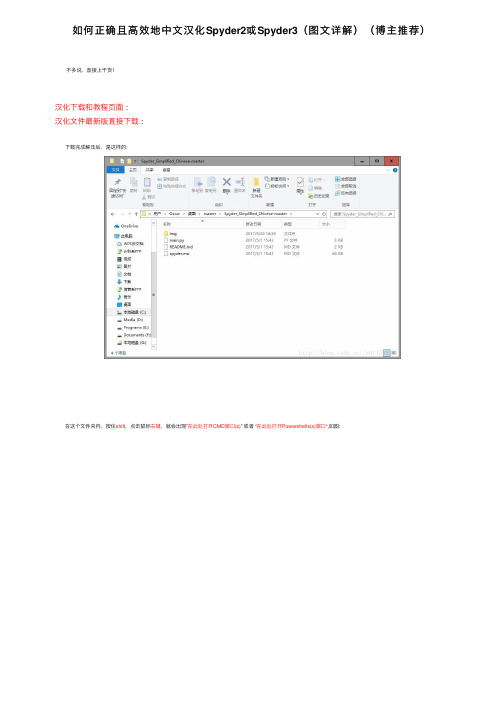
如何正确且⾼效地中⽂汉化Spyder2或Spyder3(图⽂详解)(博主推荐) 不多说,直接上⼲货!汉化下载和教程页⾯ :汉化⽂件最新版直接下载 : 下载完成解压后,是这样的: 在这个⽂件夹内,按住shift,点击⿏标右键,就会出现”在此处打开CMD窗⼝(s)” 或者 “在此处打开Powershells(s)窗⼝“,如图: 如果是CMD,点开之后,输⼊: python main.py ,如下图: 如果是Powershell,点开之后,输⼊ : python .\main.py ,如下图: 结果分别是: 现在汉化已经完成,重新打开Spyder,找到Tools –> Perferences 点开之后,按图⽚所⽰顺序找到语⾔选项。
选择简体中⽂,然后点击Apply,如下图 点击之后会提⽰重启,点击确定就会⽴即重启,重启之后便是中⽂ 成功! 当然,这仅仅是针对初学者,最好还是⽤英⽂。
当然,可以切换中英⽂嘛。
欢迎⼤家,加⼊我的微信公众号:⼤数据躺过的坑⼈⼯智能躺过的坑同时,⼤家可以关注我的个⼈博客:/zlslch/ 和 /lchzls/ /sunnyDream/详情请见:/zlslch/p/7473861.html ⼈⽣苦短,我愿分享。
本公众号将秉持活到⽼学到⽼学习⽆休⽌的交流分享开源精神,汇聚于互联⽹和个⼈学习⼯作的精华⼲货知识,⼀切来于互联⽹,反馈回互联⽹。
⽬前研究领域:⼤数据、机器学习、深度学习、⼈⼯智能、数据挖掘、数据分析。
语⾔涉及:Java、Scala、Python、Shell、Linux等。
同时还涉及平常所使⽤的⼿机、电脑和互联⽹上的使⽤技巧、问题和实⽤软件。
只要你⼀直关注和呆在群⾥,每天必须有收获对应本平台的讨论和答疑QQ群:⼤数据和⼈⼯智能躺过的坑(总群)(161156071)。
- 1、下载文档前请自行甄别文档内容的完整性,平台不提供额外的编辑、内容补充、找答案等附加服务。
- 2、"仅部分预览"的文档,不可在线预览部分如存在完整性等问题,可反馈申请退款(可完整预览的文档不适用该条件!)。
- 3、如文档侵犯您的权益,请联系客服反馈,我们会尽快为您处理(人工客服工作时间:9:00-18:30)。
4 字典
#! /usr/bin/python x={'a':'aaa','b':'bbb','c':12}print (x['a'])print (x['b'])print (x['c'])for key in x: ("Key is %s and value is %s" % (key,x[key])) ''' 知识点:
f.close()
f=open(spath,"r") # Opens file for readingfor line in f: 是:%s"%line)
print(" 每 一 行 的 数 据
f.close()
知识点:
open 的参数:r 表示读,w 写数据,在写之前先清空文件内容,a 打开并附加内容. 打开文件之后记得关闭
no be empty.")try:
i=int(s)except Exception as err:
print(err)finally: # Clean up action
print("Goodbye!")
9 文件处理 对比 Java,python 的文本处理再次让人感动
#! /usr/bin/python spath="D:/download/baa.txt" f=open(spath,"w") # Opens file for writing.Creates this file doesn't exist.f.write("First line 1.\n") f.writelines("First line 2.")
1 你好
#打开新窗口,输入:#! /usr/bin/python # -*- coding: utf8 -*- s1=input("Input your name:")print("你好,%s" % s1)''' 知识点:
* input("某字符串")函数:显示"某字符串",并等待用户输入. * print()函数:如何打印. * 如何应用中文 * 如何用多行注释 '''
# b.pyfrom a import add_func # Also can be : import aprint ("Import add_func from module a")print ("Result of 1 plus 2 is: ")print (add_func(1,2)) # If using "import a" , then here should be "a.add_func"
Python 已经是3.1版本了,与时俱进更新教程.
本文适合有 Java 编程经验的程序员快速熟悉 Python 本文程序在 windows xp+python3.1a1 测试通过. 本文提到的 idle 指 python shell,即安装 python 后你在菜单看到的 IDLE(python gui) 在 idle 里 ctrl+n 可以打开一个新窗口,输入源码后 ctrl+s 可以保存,f5运行程序. 凡打开新窗口即指 ctrl+n 的操作.
b="test" c=str(a)+b d="1111" e=a+int(d)#How to print multiply valuesprint ("c is %s,e is %i" % (c,e))''' 知识点:
* 用 int 和 str 函数将字符串和数字进行转换 * 打印以#开头,而不是习惯的// * 打印多个参数的方式 '''
10 类和继承
class Base: def __init__(self): self.data = [] def add(self, x): self.data.append(x) def addtwice(self, x): self.add(x) self.add(x)# Child extends Baseclass Child(Base):
知识点: Python 不用{}来控制程序结构,他强迫你用缩进来写程序,使代码清晰.
定义函数方便简单 方便好用的 range 函数
8 异常处理
#! /usr/bin/pythons=input("Input your age:")if s =="": raise Exception("Input must
* 条件和循环语句 # * 如何得到控制台输入
print ("Zero")else: print print (x, len(x))#知识点:#
7 函数
#! /usr/bin/python # -*- coding: utf8 -*- def sum(a,b):
return a+b
func = sum r = func(5,6)print (r)# 提供默认值 def add(a,b=2): r=add(1)print (r) r=add(1,5)print (r)
return a+b
oChild =Child() oChild.add("str1")print (oChild.data)print (oChild.plus(2,3))''' 知识点:
* self:类似 Java 的 this 参数 '''
def plus(self,a,b):
11 包机制 每一个.py 文件称为一个 module,module 之间可以互相导入.请参看以下例子: # a.pydef add_func(a,b): return a+b
中文和英文的字符串长度是否一样?
#! /usr/bin/python # -*- coding: utf8 -*s=input("输入你的中文名,按回车继续");print ("你的名字是 : " +s)
l=len(s)print ("你中文名字的长度是:"+str(l))
知识点: 类似 Java,在 python3里所有字符串都是 unicode,所以长度一致.
return a+b
一个好用的函数
#! /usr/bin/python # -*- coding: utf8 -*- # The range() functiona =range (1,10)for i in a:
print (i)
a = range(-2,-11,-3) # The 3rd parameter stands for stepfor i in a: print (i)
2 字符串和数字
但有趣的是,在 javascript 里我们会理想当然的将字符串和数字连接,因为是动态语言嘛.但 在 Python 里有点诡异,如下:
#! /usr/bin/python a=2 b="test" c=a+b
运行这行程序会出错,提示你字符串和数字不能连接,于是只好用内置函数进行转换
#! /usr/bin/python #运行这行程序会出错,提示你字符串和数字不能连接,于是只好用内置函数进行转换 a=2
6 条件和循环语句
#! /usr/bin/python#条件和循环语句 x=int(input("Please enter an integer:"))if x<0:
x=0 print ("Negative changed to zero")elif x==0: ("More") # Loops Lista = ['cat', 'window', 'defenestrate']for x in a:
* 将他当 Java 的 Map 来用即可.'''
5 字符串 比起 C/C++,Python 处理字符串的方式实在太让人感动了.把字符串当列表来用吧.
#! /usr/bin/python word="abcdefg" a=word[2]print ("a is: "+a) b=word[1:3]print ("b is: "+b) # index 1 and 2 elements of word.c=word[:2]print ("c is: "+c) # index 0 and 1 elements of word.d=word[0:]print ("d is: "+d) # All elements of word.e=word[:2]+word[2:]print ("e is: "+e) # All elements of word.f=word[-1]print ("f is: "+f) # The last elements of word.g=word[-4:-2]print ("g is: "+g) # index 3 and 4 elements of word.h=word[-2:]print ("h is: "+h) # The last two elements.i=word[:-2]print ("i is: "+i) # Everything except the last two charactersl=len(word)print ("Length of word is: "+ str(l))
